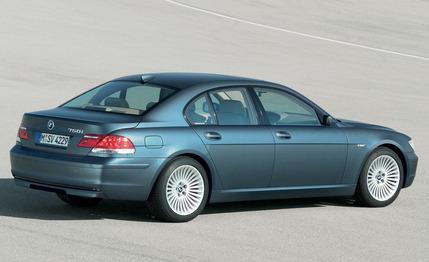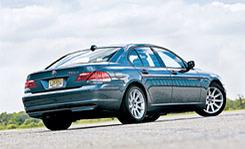
 Short Take Road Test
Short Take Road Test
In our last luxury-barge comparison test ("$70,000 Luxury Sedans," C/D, December 2003), the BMW 745i bettered its peers in several categories, including engine torque, 70-to-standstill braking, roadholding, and 0-to-60, 0-to-100, and quarter-mile acceleration. Yet despite its high frequency of first-place performance finishes, our collective ballots put it in third. The culprits? Surprisingly, there were really just two that hampered the bad-ass Bimmer--frumpy, big-butt styling and iffy ergonomics, the latter magnified by the iDrive controller that was as enjoyable and easy to use as limp chopsticks. How can it be the Ultimate Driving Machine when driving iDrive drives you crazy?
For the 2006 model year, BMW has made significant amendments to the fifth iteration of its fourth-generation 7-series, many of which address the styling and ergonomic shortcomings that irked us in '03.
The most noticeable, albeit subtle, alterations are superficial: a restyled front fascia--larger kidney grilles, a new bumper, a raised hood with fresh lines, and reworked headlamp lenses sans scalloped edges--and rear end, whose newly shaped trunklid incorporates taillamp assemblies that help shape a more uniform, less offensive hiney. The result is a better-looking, more-cohesive 7 that proves being superficial has its merits.
Inside, the changes are equally subtle, although less effective. In addition to new climate-control knobs that BMW says offer improved tactile feel to the user, the cockpit's interface now communicates via a newly shaped iDrive controller that sports a leather insert on top, as if it were protecting a balding head from sunburn. The look and the feel are upgrades, but the usability remains frustrating and aggravating, despite submenus that are easier to use. Keep trying, BMW (read "Get rid of it!").
One component BMW didn't need to replace was the buttery 325-hp, 4.4-liter V-8, which already propelled the old 745i to the head of the pack. Fortunately, the spur of competition and BMW's lust for higher performance meant the face-lifted 7 needed more engine than the old 4.4. Thus, the 750i is motivated by a 4.8-liter V-8--essentially the same engine used in the rambunctious X5 4.8is--whose extra 401cc generates 35 more horsepower and 30 additional pound-feet of torque, bringing both the pony and pound-feet totals up to 360.

 In testing, the 4.8 showed that the new 750i badge is more than a marketing ploy. Zero to 60 required just 5.4 seconds, a substantial improvement over the 745's already best-in-class 6.0-second mark, and the quarter-mile came and went in 13.9 seconds at 103 mph, another big dip from the previous car's 14.6 at 97. More impressive was the 4.8's ability to keep pulling even as speeds kept rising. Compared with the 15.3 ticks it took the 745 to accelerate from 0 to 100, the 750 needed just 13.1. The sprint to 120 showed even more separation--23.4 seconds for the old car, 19.6 for the 750. What's more, the 4.8 retains the 4.4's creamy nature yet spices it up with a throatier engine growl befitting the added performance.
In testing, the 4.8 showed that the new 750i badge is more than a marketing ploy. Zero to 60 required just 5.4 seconds, a substantial improvement over the 745's already best-in-class 6.0-second mark, and the quarter-mile came and went in 13.9 seconds at 103 mph, another big dip from the previous car's 14.6 at 97. More impressive was the 4.8's ability to keep pulling even as speeds kept rising. Compared with the 15.3 ticks it took the 745 to accelerate from 0 to 100, the 750 needed just 13.1. The sprint to 120 showed even more separation--23.4 seconds for the old car, 19.6 for the 750. What's more, the 4.8 retains the 4.4's creamy nature yet spices it up with a throatier engine growl befitting the added performance.
Braking and roadholding performance are in effect unchanged--70 to 0 in 164 feet (vs. 163) and the skidpad at 0.88 g (vs. 0.87)--as is the sound level at a 70-mph cruise, which drops deeper into the abyss from 65 dBA to 64.

 Which brings us to the 750i's downside, assuming you view it as such. It is so adept at quickly covering ground--be it straight or curvy--and so quiet, smooth, and compliant doing so that the experience has become more numbing than involving. Whereas the previous-generation 7 was the big-sedan epitome of creating a driver-to-machine relationship, the current-generation car--certainly the 750--is proficient at taking the driver to new performance levels without the driver's really feeling as if he were part of the process. Perhaps it's the price we must pay for technology such as active roll stabilization and variable-ratio steering, both of which lessen the feel of going fast while allowing you to go faster, but it seems that a BMW should drive more like a BMW and not like an extremely capable, extremely quick Lexus.
Which brings us to the 750i's downside, assuming you view it as such. It is so adept at quickly covering ground--be it straight or curvy--and so quiet, smooth, and compliant doing so that the experience has become more numbing than involving. Whereas the previous-generation 7 was the big-sedan epitome of creating a driver-to-machine relationship, the current-generation car--certainly the 750--is proficient at taking the driver to new performance levels without the driver's really feeling as if he were part of the process. Perhaps it's the price we must pay for technology such as active roll stabilization and variable-ratio steering, both of which lessen the feel of going fast while allowing you to go faster, but it seems that a BMW should drive more like a BMW and not like an extremely capable, extremely quick Lexus.
Nonetheless, this new 750i is better in every way than the car it replaces. That in and of itself should be enough to keep the BMW faithful happy, the competition worried, and us anxious for another comparo.